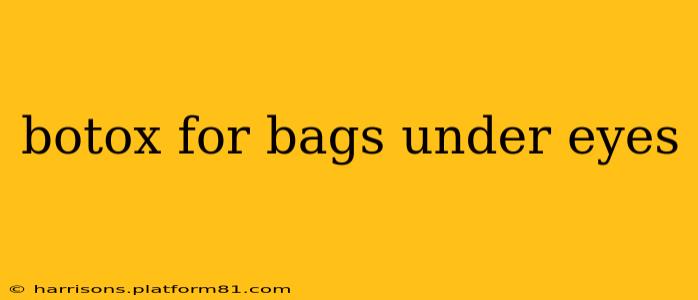Under-eye bags can be a frustrating cosmetic concern, impacting confidence and making you look older than you feel. While various treatments exist, Botox for under-eye bags is a popular option. This comprehensive guide explores whether Botox is the right solution for you, addressing common questions and concerns.
What are under-eye bags?
Under-eye bags, also known as lower eyelid bags or puffiness, are caused by a combination of factors. These include genetics, aging (loss of skin elasticity and fat pad descent), fluid retention, and lack of sleep. The fat pads naturally present under the eyes can protrude more noticeably as we age, leading to the appearance of bags. This isn't simply a cosmetic issue; sometimes, underlying medical conditions contribute.
Can Botox treat under-eye bags?
Botox itself doesn't directly address the fat pads causing under-eye bags. It works by relaxing the muscles responsible for wrinkles and fine lines. Therefore, it's not a primary treatment for under-eye bags. However, Botox can play a supporting role in some cases.
How Botox helps with under-eye bags:
- Treating associated wrinkles: Botox can effectively minimize crow's feet and other wrinkles around the eyes, contributing to a more refreshed overall appearance, even if the bags remain. This can make the bags seem less noticeable.
- Addressing muscle pull: In some cases, muscle activity can worsen the appearance of under-eye bags. Botox can relax these muscles, slightly improving the bag's appearance.
- Combination therapy: Botox is often used in combination with other treatments, such as fillers or blepharoplasty (eyelid surgery), for a more comprehensive approach to addressing under-eye concerns.
What are the alternatives to Botox for under-eye bags?
Several other options exist for treating under-eye bags, each with its own pros and cons:
- Fillers: Dermal fillers can directly address the volume loss and fat pad descent that contribute to under-eye bags, providing a more immediate and noticeable improvement.
- Blepharoplasty (eyelid surgery): This surgical procedure removes excess skin and fat from the eyelids, providing a long-lasting solution for more severe cases of under-eye bags.
- Lifestyle changes: Getting enough sleep, staying hydrated, and using cool compresses can help reduce puffiness temporarily.
- Topical treatments: Some creams and serums claim to reduce the appearance of under-eye bags, although their effectiveness varies.
Is Botox safe for under the eyes?
Botox is generally safe when administered by a qualified and experienced professional. However, incorrect injection techniques can lead to undesirable side effects such as drooping eyelids (ptosis) or unevenness. It's crucial to select a board-certified dermatologist or plastic surgeon with extensive experience in facial aesthetics.
What are the risks and side effects of Botox for under-eye bags?
While generally safe, Botox injections can have potential side effects, including:
- Bruising: Minor bruising at the injection site is common and usually resolves within a few days.
- Swelling: Swelling may occur temporarily.
- Asymmetry: In rare cases, uneven results can occur.
- Drooping eyelids (ptosis): This is a rare but possible side effect if the Botox is not injected precisely.
How long does Botox last for under-eye bags?
The effects of Botox usually last for 3-4 months. After this, the treatment may need to be repeated to maintain the results.
How much does Botox cost for under-eye bags?
The cost of Botox varies depending on several factors, including the amount of Botox used, the location of the clinic, and the experience of the practitioner. It's best to consult with a professional for a personalized quote.
Conclusion:
Botox is not a stand-alone treatment for under-eye bags, but it can be a valuable component of a comprehensive approach, particularly when addressing associated wrinkles or muscle activity. Consider consulting a board-certified dermatologist or plastic surgeon to determine the best course of treatment for your specific needs and concerns. They can assess your individual situation and recommend the most appropriate and effective solution. Remember, realistic expectations are key to a satisfying outcome.
